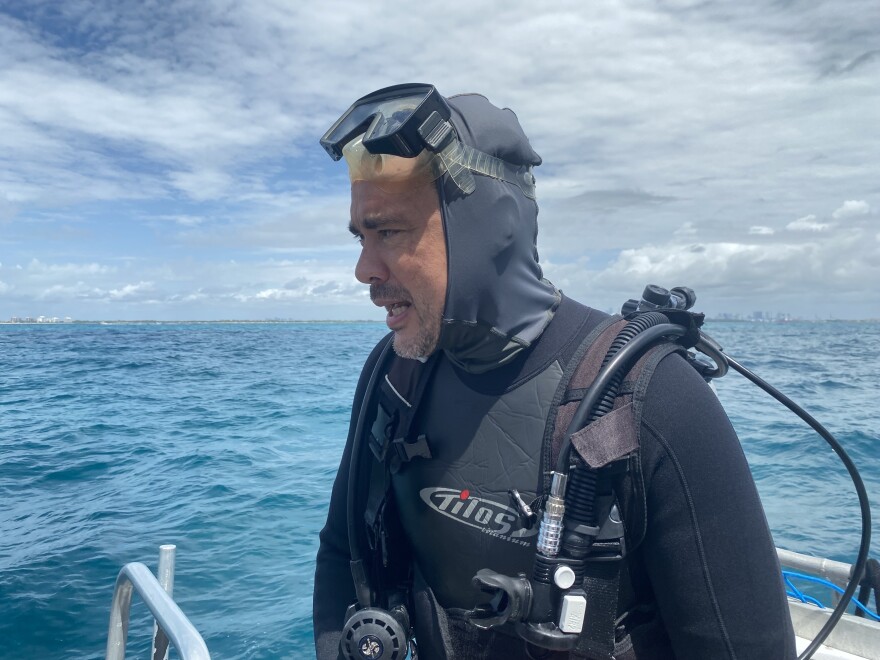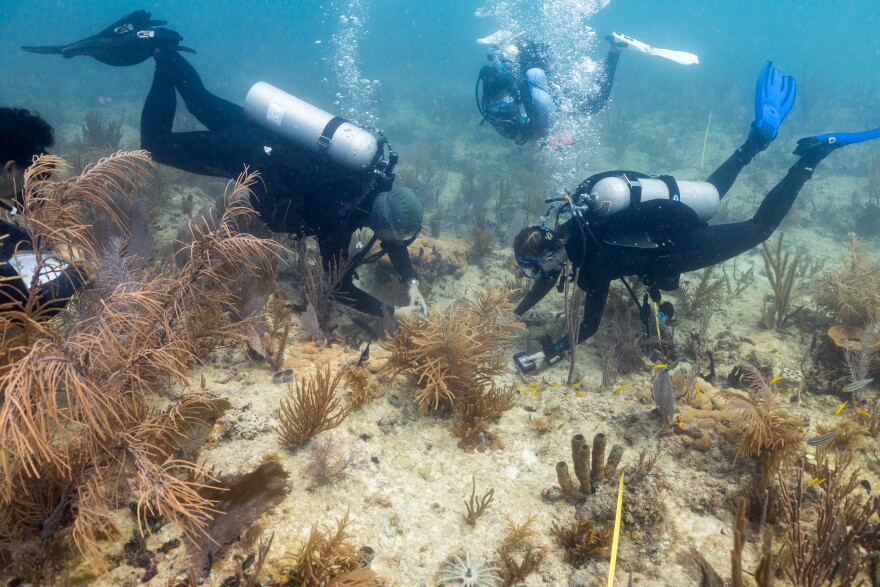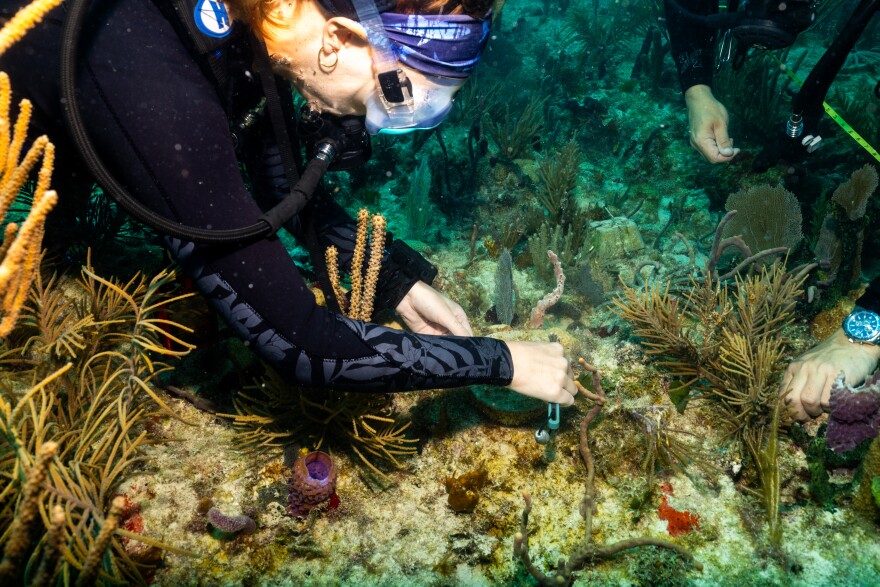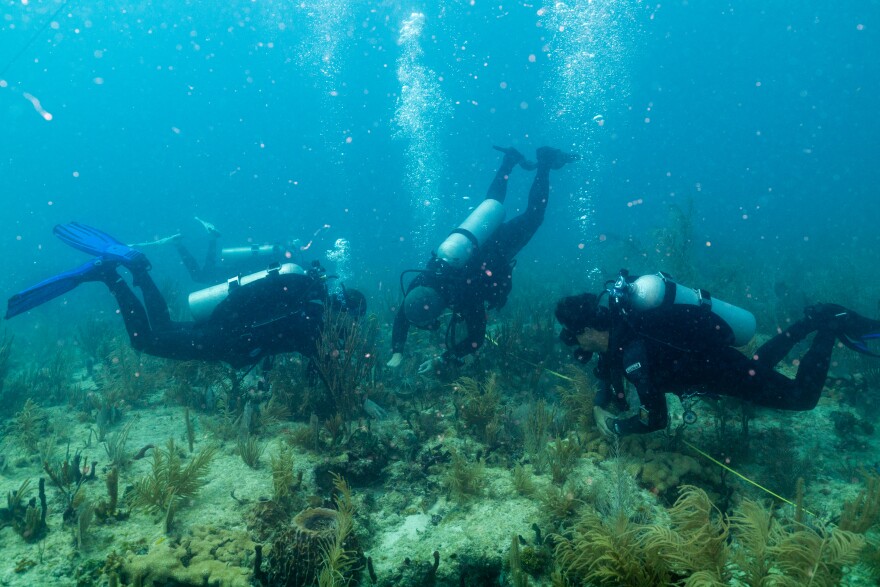Emotions ran high one recent Sunday morning on Biscayne Bay, where University of Miami marine researchers bid farewell to the "coral babies" they’d nurtured for months.
Kate Etter, a coral recruit technician at UM's Coral Reef Futures Lab, was at the dock of Diver’s Paradise at Crandon Marina to see the new breed of coral off to their first planting in the reefs.
“Without coral, we’re not going to have different types of fish or different types of herbivores that, together, work in a group to create a thriving environment,” she said.
These elkhorn coral babies, affectionately called “Flonduran” corals by researchers at the UM Rosenstiel School were planted in Biscayne Bay on July 1. It is the first time internationally crossbred corals have ever been planted in wild reefs.
UM professor Andrew Baker said that restoration efforts for Florida’s dwindling coral reefs don’t fit the perception most people read in history books. He teaches marine biology and ecology at the UM Rosenstiel School. He's also director of the Coral Reef Futures Lab.
READ MORE: Florida reefs are in trouble. Could the answer lie in coral from the Caribbean?
“It's gonna be very difficult to go back to the reefs of the past,” he said. “I think restoration these days has as its goal a way of securing the biodiversity, the species diversity that we have."
Benefits of coral reefs
Coral reefs in Biscayne Bay are important not only for the many species and marine life they house and nurture, but for those who live off its coasts and swim in its waters.
According to the Biscayne National Park website, healthy reefs provide shoreline protection for coastal communities by absorbing wave energy and reducing flood risk.
More than three-fifths of the world's coral reefs have been impacted by coral bleaching due to extreme heat the ocean absorbs.
In the Lower Florida Keys, the iconic antler-shaped elkhorn coral was wiped out last year.
Elkhorn coral’s large branching structure creates a vital habitat for marine life, helps reefs grow, and acts as a natural barrier protecting coastlines from storms.
Once abundant across Florida and the Caribbean, elkhorn coral populations have declined by over 95% since the 1980s due to disease, warming oceans, and other negative environmental factors — making it a key focus of coral restoration efforts.
According to UM researchers, from the Dry Tortugas to St. Lucie Inlet, Florida’s Coral Reef is the only living coral barrier reef in the continental United States— and the world's third-largest barrier reef system.
Looking for answers
For more than five years, Baker and his lab scoured the Caribbean for an answer to this massive loss. From Cuba, to Mexico and Belize, they found what they were looking for in Tela, Honduras: coral that was not only thriving, but thriving in very similar conditions to the ones that wiped out Florida’s elkhorn.
According to Baker, the Coral Futures team worked with the Honduran government which has a “really interesting and unusual” reef in continental Honduras.
“ The reefs there are thriving, even though they're much warmer than Florida [waters] and they suffer from a lot of nutrient pollution from agriculture and so on,” Baker said. “Exactly the kinds of threats that Florida is facing, and is going to face more of in the next few decades.”

Back on Biscayne Bay, Baker and doctoral graduate student, Fabrizio Lepiz geared up to plant coral to help restore the reef.
“ Being here just feels very surreal and being able to be part of this world first … is a really full circle moment for me,” Lepiz said.
After the planting, both Baker and Lepiz noted this would not be the only time they’d be going out in these waters.
“We're really gonna take care of these guys, so we're coming back as soon as tomorrow,” Lepiz said.
“They're probably the most monitored corals we've ever monitored," he said. "They're very valuable, precious to us. We stand to learn a lot.”

Researchers and students alike spoke with anticipation and excitement when talking about the coral reef project.
Keri O’Neil is the director and senior scientist of the Coral Conservation Program at the Florida Aquarium. She said the entire process — from bringing the Honduran coral and crossbreeding them in the Florida Aquarium's Apollo Beach lab — has been nerve-wracking. She helped prepare 34 coral babies with what's called "outplanting."

“We were lucky enough that we got some Florida parents and some Elkhorn parents [that spawned] on the same nights, and I think we made 14 or 15 different crosses between 300 parents,” she said. “Sometimes you never know if the parents aren't gonna be compatible. There were a lot of things that had to kind of line up just to get them to be able to even spawn and cross in the first place.”
Since the outplanting, the UM Coral Futures Lab has gone out almost daily, depending on the weather. They say the corals are secure and healthy.
In bidding farewell that recent Sunday morning, the UM researchers expressed hope that their work would see the corals grow and thrive.
Baker said the crossbreeding of Floridian and Honduran coral is the beginning of the long process of helping ecosystems adapt to ever changing and intensifying conditions.
“Those ecosystems have a chance over the long term of coming back the way they used to be,” he said. “But it is a long game. It's just like planting an old growth forest from seeds takes decades or hundreds of years for that to reach.”
Sign up for WLRN’s environment newsletter Field Notes to receive our insider’s guide for living in South Florida’s changing landscape. Get original reporting and recaps, with context, delivered to your inbox every Friday. Subscribe here.






